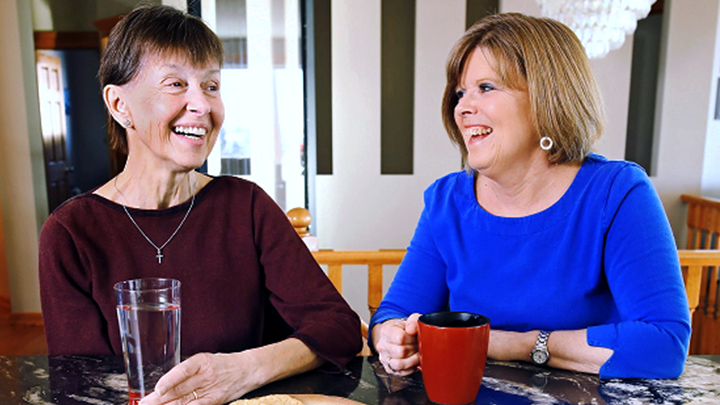
March 13, 2019

Linda Soltys, left, and Jane O’Connor share a lighter moment and a special connection thanks to living kidney donation. “Jane saved my life,” says Soltys. “She is my angel on Earth. So my mission is to take care of that kidney.”
Living Donor Services Transplant Services
University of Alberta Hospital in Edmonton
Phone: 780-407-8698
Toll Free: 1-866-253-6833 (Canada only)
Email: livingdonors@albertahealthservices.ca
Southern Alberta Transplant Program
Living Donor Program in Calgary
Phone: 403-944-4635
Email: ALTRAFMC.Living.Donor@albertahealthservices.ca
For more information on living kidney donation or kidney transplantation, please visit myhealth.alberta.ca/HealthTopics/kidney-transplant.
Story by Debby Waldman | Photo by Ewan Nicholson
SPRINGBANK — Linda Soltys and Jane O’Connor are always running into people they know, whether on a walk or at the golf course. Their close-knit community, just west of Calgary, is the kind of place where a smile can lead to a conversation or a dinner date.
For Soltys and O’Connor, however, a casual encounter led to something amazing neither could have foreseen — an organ donation and a new lease on life.
The pair first crossed paths in 2009 through O’Connor’s husband, Mike, who met Soltys and her husband, Jerry, while dog-walking. Soltys, then in recovery after having a kidney removed after cancer, bonded quickly with O’Connor. Soon the two couples were spending time together to enjoy the outdoors, play shuffleboard, watch curling and share meals.
Life with one kidney didn’t seem all that difficult. “It didn’t stop me from doing anything,” says Soltys. “I worked, I traveled, I hiked — I didn’t have any limitations.”
But life with no kidney proved to be an altogether another story.
In 2013, after Soltys had her second kidney removed, her quality of life plummeted. At first, she travelled to the hospital three times a week for dialysis, connected to a machine to remove toxins from her blood, now that she lacked a kidney to do the job.
In time, Soltys learned to perform her own dialysis at home, which proved less than ideal.
“I wasn’t a typical patient,” she says. Dialysis didn’t work as well for her; it took more time, between 10 to 12 hours each and every day, hooked up to the machine, in the months leading up to her transplant.
Dialysis ruled her life. She couldn’t do anything spontaneous. Her travel was limited to Calgary.
Upon learning she qualified to receive a kidney transplant, she felt hope, and saw dialysis as her bridge to cross — until she could once again have a kidney and lead a normal, healthy life.
It felt like an early Christmas present in late 2013 — but also a challenge — when her physician told her she could start looking for a donor.
“While the number of patients with chronic kidney disease has gone up, the number of living donations over the past decade has remained the same,” says Dr. Soroush Shojai, a transplant nephrologist at the University of Alberta Hospital and co-chair of the Living Donor Kidney Transplant Working Group.
The working group is part of the Kidney Health Strategic Clinical Network, a provincial network that brings together patients and healthcare professionals to improve kidney care and health outcomes.
”People may not know that kidney transplant is possible with donors who are unrelated to them,” says Dr. Shojai.
Soltys hoped that someone who knew her, perhaps a relative, might come forward.
“I was always uncomfortable telling anybody that I needed a transplant,” she says. “I would have never asked anybody, because I didn’t want them to feel they had to, out of pity or guilt. I wanted it to be their idea.”
The O’Connors visited the Soltyses often, as Linda couldn’t really get out much. They recall how It broke their hearts to see how her health was failing, how restricted her life had become.
“One night, on our way home, Mike looked at me and said, ‘We have to find Linda a kidney,’” O’Connor recalls. “I paused, and then said, ‘Maybe I can do that.’ And away we went.”
Due to the extensive testing process for living donors, protocol calls for only one potential donor to be tested at a time. When O’Connor called to start the process, she was advised that another potential donor was then being tested, so she would have to wait.
When the donor ahead of O’Connor proved incompatible for Soltys, O’Connor began her own evaluation process, which involved blood tests, a renal scan, CT scans, physicals and a psychological exam to ensure that she was donating her kidney because she wanted to, not because she felt pressured.
“Deciding to become a living donor for someone can shorten the time for those waiting for a transplant,” says Dr. Shojai. “The first step is to contact the transplant program closest to where they live. After the initial call, we work with them through a process that involves comprehensive tests over several months.”
Around Halloween 2014, O’Connor told Soltys that she had passed all the tests and the transplant was a go. Their surgeries were performed in January 2015. Shortly afterwards, they felt better and continued to lead active, healthy lives.
“When a patient receives a kidney from a living donor, they tend to feel healthier, live longer than dialysis patients and have greater freedom to travel and resume their life,” adds Dr. Shojai.
“Jane saved my life,” says Soltys. “There’s no other way to say it. She is my angel on earth. So my mission is to take care of that kidney.”
See Linda and Jane talk about their journey through living kidney donation.